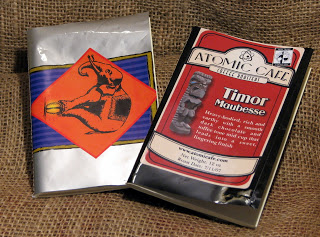If you know me personally you know tht I love coffee. I love almost all forms of coffee but my favorite is fresh locally roasted coffee. There is really nothing like it. It’s a flavor sensation unlike any other coffee. Once you’ve had a really good fresh roasted coffee you can’t go back to folgers or other commercially available ground coffees.
My recent excursions into locally roasted coffee have led me to several new brands. One is not really a new brand it belongs to the coffee shop I walk to in my town called Atomic Coffee. The roast and brew their coffee on the premises and in the front room of their shop you can see the roaster. Coffee is fairly priced and damn good, plus they offer free WiFi.
Recently they have started to sell their coffee in limited amounts in some local stores. I saw a bag recently and had to buy it. Wonderful, even better at home than in the store. Truly awesome. If you are ever in Beverly Mass, I suggest you get over to Atomic and have some coffee and buy a bag to take home.
Then a recent excursion had me run into a brand called Karma Coffee. Silver foil bag and an elephant on the label. I was told by the guy selling it (Dan) that it’s a small roaster and coffee shop in Weston Mass. They roast in small batches and sell a lot of coffee. I was game so I bought myself a bag of Ethiopian Harrrar I can’t compare it to the stuff in the shop but if it’s half as good as the stuff I brewed at home that it’s got to be amazing stuff.
At this point you have got to be asking yourself what this has to do with bookbinding.
Patience!
I took one look at the bags and I wondered how I could make that into a book. Seriously I almost always think about how I can make something into a book. A coworker pointed out a sign- made of thick 1/8th inch plastic and asked if I could somehow make that into a book. I said of course I can.
So I cleaned the bag out- some spray cleaner really helped. (a quick I noticed item here- the locally roasted bags had far fewer oils on the inside of the bag than a non-local fresh roast bag that I also tried this with, and thus were far easier to clean.)
I then cut the vacuum valve off, and trimmed the bag to a useable piece. I then stitched it just like I would a regular jotter. I then trimmed it all down to the right size.
On a recycling note, most coffee bags are made of mylar and layered with plastic. They are not very recyclable. While I wasn’t able to re-use and upcycle ALL the bag I was able to get a lot of the bag into a new use. I’m pretty happy with it.

